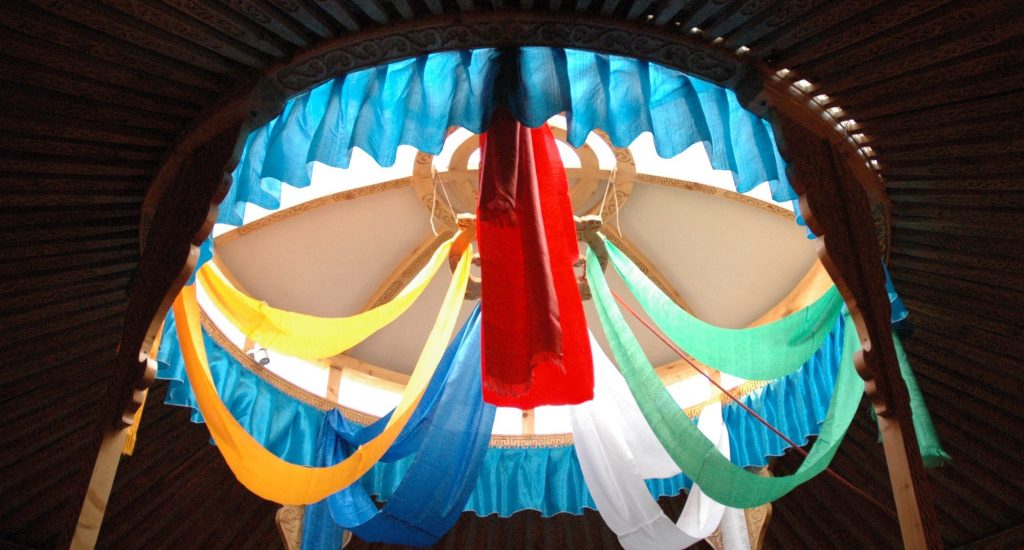
The nomadic lifestyle makes Mongolians very close to nature. Being close means that they are dependent on nature.
To be in harmony, Mongols decipher and study nature until they read a philosophy of adaptation.
Over time, people understood that the cosmos is filled with different energies, negative and positive. They realized that it is important to attract positive energy through correct behavior, spiritually and physically. Correct behavior generates good lifestyle habits. So, over the generations, the locals have developed symbolism anchored in their spiritual belief and visible in the simplest moments of daily life.
For Mongolians, symbolism can occur in these following forms:
- Gestures
- Colors
- Patterns
- Words
- Numbers
Gestures
The symbolic Gestures follow the tradition of the Right side and the Movement of the Sun, aka Clockwise direction. These directional symbolism will appear anywhere, from entering one’s home to using everyday utensils.
- When inside a yurt, as soon as you cross the threshold to enter someone’s house, you must go in the clockwise direction and sit on the guest area.
- When preparing milk tea, your host proceeds so that the tea is stirred in the direction of the sun. Then the tea is served by their right hand. REMEMBER: Giving or taking with one’s left hand is considered very rude.
- Mongolia’s ancient religion is shamanism, thus many ceremonies are still practiced today. A common thing one will encounter in the Mongolian land is a wooden or stone hut-like heaps used as altars, called “Ovoo”. The locals make offerings to the holy spirits of the land by completing three turns around the “Ovoo” in the direction of the sun (clockwise).


Colors
- Blue – the color of the sky is a symbol of eternity
- Green – the color of the earth, but also of wisdom
- White – like milk, it represents purity
- Red – the color of fire, symbolizes of prosperity
- Yellow – constitutes religion and joy.

These colors are popularly depicted in the ceremonial silk scarves (like the ones in the photo below). These scarves are often gifted to guests or kept at the home altar.


Patterns
The painted or engraved patterns on a Mongol’s furniture and articles represent eternity, continuity and peace. The ornamental patterns symbolize the immortal movement of life.
You can see it in all nomadic families’ settlements. The wooden structures of the yurt and the traditional chests are decorated with patterns of eternal existence, continuous happiness and perpetual prosperity of the home.
To learn more about the symbolism inside a yurt, such as importance of the four directions, click here.


Words
Daily speech is symbolic as well, as Mongols believe words are the reflections of one’s soul.
As a saying goes: “Амны бэлгээс ашдын бэлгэ” meaning “From good words come good fortune” is used everyday by the elders for the younger generation to remind them to have a positive mindset and speech.
According to Buddhist philosophy, the Mongols are strongly influenced by the concept of karma. Karma, the fruit of all one’s good and bad actions, is believed to be realized physically, orally and intentionally. So people try to speak positively in everyday life. Even if they are sick, Mongolians say that everything is fine. Mongolians use a lot of praise to symbolize a happy future.


Numbers
Numbers have symbolic, religious and spiritual significance, as well. The most symbolic figures among Mongolians are 2, 3, 9 and 108.
- 2 is the source of life, symbolically opposed to 1, the symbol of loneliness (even though its the symbol of a beginning).
- 3 is the symbol of the coordination of the 3 beats: Past, Present and Future.
- 9 is a number which designates a large integral. There are many expressions including this figure; nine wishes, nine treasures, nine flags of Genghis Khan, and ninety-nine heavens in shamanism etc.
- 108 is the number that all Mongolians know by heart, like the 108 beads in a Buddhist rosary.
Disclaimer: Ovoo photo








I was searching for some words about fire symbols, been through many blogs but can’t find what I was looking for, thanks to you, your topic really helped me, thank you so much.